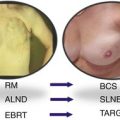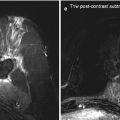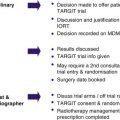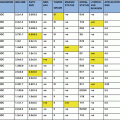EBRT
IORT
p (95 % CI)
Total
No. (%)
112 (47.1)
126 (52.9)
238
Non-responders
4
0
4
Age, years (mean)
65.74 (SD 6.17)
64.76 (SD 6.45)
0.23 (−0.64–2.60)
65.22 (SD 6.33)
Follow-up, months (mean)
17.06 (SD 10.39)
17.36 (10.64)
0.87
17.22 (SD 10.50)
Endocrine therapy, n (%)
0.28
No ET
95 (84.8)
99 (79.4)
194 (81.9)
AI
17 (15.2)
26 (20.6)
43 (18.1)
TAM
0
0
0
Unknown
0
0
0
Tumour size, mm (mean)
10.75 (SD 3.59)
10.65 (SD 4.14)
0.85 (−0.91–1.12)
10.70 (SD 3.89)
Lymph nodes (mean)
2.32 (SD 1.44)
2.24 (SD 1.33)
0.67
2.28 (SD 1.38)
WHO, n (%)
Invasive ductal
94 (83.9)
106 (84.1)
200 (84.0)
Invasive lobular
1 (0.9)
0
1 (0.4)
Mucinous
5 (4.5)
6 (4.8)
11 (4.6)
Medullary
0
0
0
Papillary
1 (0.9)
3 (2.4)
4 (1.7)
Tubular
5 (4.5)
8 (6.3)
13 (5.4)
Others
3 (2.7)
2 (1.6)
5 (2.1)
Unknown
3 (2.7)
1 (0.8)
4 (1.7)
The prevalence of pain was 33.9 % in the EBRT group and 24.6 % in the IORT group (p = 0.11) (Table 11.2). Pain localisation was similar in the two groups. Pain intensity was low for most patients and was not significantly different between the two groups: of the patients who experienced pain, 71 % in the EBRT group and 77 % in the IORT group scored 3 or lower on the numerical rating scale. As regards frequency of pain, 86.8 % of the patients reporting pain in the EBRT group said that they experienced pain on a weekly basis or more often, versus 64.5 % of the IORT patients (p = 0.044). The prevalence of pain elsewhere (outside the treatment area) was higher in the IORT group than in the EBRT group (40.7 % vs. 26.4 %) (p = 0.027). The prevalence of sensory disturbances was similar in the two groups.
Table 11.2
Persistent pain after breast cancer treatment in the EBRT and IORT groups (Andersen et al. 2012)
EBRT | IORT | p | Total | |
|---|---|---|---|---|
Reporting pain, n (%) | 38 (33.9) | 31 (24.6) | 0.11 | 69 (29.0) |
cont. OR (95 % CI) | 1.57 (0.90–2.77) | 1 | ||
Localisation, n (%) | ||||
Breast | 31 (81.6) | 26 (83.9) | 0.80 | 57 (82.6) |
Side of the chest | 12 (31.6) | 6 (19.4) | 0.25 | 18 (26.1) |
Axilla | 19 (50.0) | 12 (38.7) | 0.35 | 31 (44.9) |
Arm | 5 (13.2) | 7 (22.6) | 0.30 | 12 (17.4) |
Pain in more than 1 area, n (%) | 21 (55.3) | 15 (48.4) | 0.57 | 36 (52.2) |
NRS (median, IQR) | ||||
Worst (overall)a | 3 (2) | 3 (1) | 0.87 | |
Breast | 2 (1) | 3 (1) | 0.98 | |
Side of the chest | 2,5 (3) | 2 (2) | 1.00 | |
Axilla | 2 (2) | 2 (2) | 0.69 | |
Arm | 5 (6) | 4 (4) | 0.68 | |
Worst pain, n (%)b | 0.59 | |||
Light pain | 27 (71.0) | 24 (77.4) | 51 (73.9) | |
Moderate pain | 10 (26.3) | 7 (22.6) | 17 (24.6) | |
Severe pain | 1 (2.6) | 0 | 1 (1.4) | |
Frequency of worst pain, n (%) | 0.090 | |||
Daily | 19 (50.0) | 11 (35.5) | 30 (43.5) | |
1–3 day/week | 14 (36.8) | 9 (29.0) | 23 (33.3) | |
Less
Stay updated, free articles. Join our Telegram channel
Full access? Get Clinical Tree
 Get Clinical Tree app for offline access
Get Clinical Tree app for offline access

| ||||





